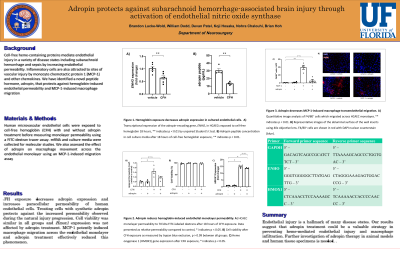Adropin protects against subarachnoid hemorrhage-associated brain injury through activation of endothelial nitric oxide synthase
Adropin Protects Against Subarachnoid Hemorrhage-associated Brain Injury Through Activation of Endothelial Nitric Oxide Synthase
Friday, April 21, 2023


Brandon P. Lucke-Wold, MD, PhD
Resident
University of Florida
Gainesville, Florida, United States
ePoster Presenter(s)
Introduction: Aneurysmal subarachnoid hemorrhage (aSAH) is a devastating illness leading to high morbidity and mortality. Unfortunately, there is a persistent lack of effective treatments to decrease mortality and improve long-term outcomes after aSAH. Adropin is a novel peptide hormone that regulates endothelial function and is highly expressed in the brain. Current evidence suggests the primary action of adropin is stimulation of eNOS.
Methods: We postulated that adropin treatment would be protective after SAH. We investigated our hypothesis by comparing pathological and functional outcomes in mice treated with adropin or vehicle at different time points post-SAH. To validate adropin treatment in an aSAH-specific physiological context, we also used a mouse model of intracranial aneurysm rupture to compare mice treated with adropin to those receiving vehicle.
Results: We found that simulated SAH decreases adropin expression in cultured brain microvascular endothelial cells and in murine brain tissue. Treatment with adropin reduced cerebral edema, preserved tight junction protein expression, and abolished microthrombosis at 1 day post-SAH. Adropin treatment also prevented delayed cerebral vasospasm, decreased neuronal apoptosis, and reduced sensorimotor deficits at seven days post-SAH. Delaying initial treatment of adropin until 24 hours post-SAH preserved the beneficial effect of adropin in preventing vasospasm and sensorimotor deficits. Mechanistically, adropin treatment increased eNOS phosphorylation (Ser1179) at one & seven days post-SAH. eNOS-/- mice treated with adropin were not protected from vasospasm or behavioral deficits, indicating a requirement of eNOS in the adropin pathway. Finally, in our aneurysm rupture model, we observed that adropin had no effect on aneurysm formation or rupture but treatment improved deficit-free survival.
Conclusion : In summary, adropin reduced cerebrovascular injury in both the acute (1 day) and delayed (7 days) phases following SAH. These are the first findings to show the protective benefit of adropin.
Methods: We postulated that adropin treatment would be protective after SAH. We investigated our hypothesis by comparing pathological and functional outcomes in mice treated with adropin or vehicle at different time points post-SAH. To validate adropin treatment in an aSAH-specific physiological context, we also used a mouse model of intracranial aneurysm rupture to compare mice treated with adropin to those receiving vehicle.
Results: We found that simulated SAH decreases adropin expression in cultured brain microvascular endothelial cells and in murine brain tissue. Treatment with adropin reduced cerebral edema, preserved tight junction protein expression, and abolished microthrombosis at 1 day post-SAH. Adropin treatment also prevented delayed cerebral vasospasm, decreased neuronal apoptosis, and reduced sensorimotor deficits at seven days post-SAH. Delaying initial treatment of adropin until 24 hours post-SAH preserved the beneficial effect of adropin in preventing vasospasm and sensorimotor deficits. Mechanistically, adropin treatment increased eNOS phosphorylation (Ser1179) at one & seven days post-SAH. eNOS-/- mice treated with adropin were not protected from vasospasm or behavioral deficits, indicating a requirement of eNOS in the adropin pathway. Finally, in our aneurysm rupture model, we observed that adropin had no effect on aneurysm formation or rupture but treatment improved deficit-free survival.
Conclusion : In summary, adropin reduced cerebrovascular injury in both the acute (1 day) and delayed (7 days) phases following SAH. These are the first findings to show the protective benefit of adropin.
